by Jill & Sarah | Dec 7, 2018 | In The Loop
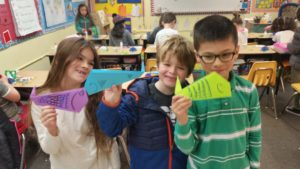 History & Geography
History & Geography
This week we continued our unit on Modern Day Japan. We learned about some important celebrations, customs, and ceremonies. We learned about how important harmony with nature is to the culture and ways it is represented in everyday life. The students designed a kimono, practiced some origami, and began writing a “postcard from Japan”. On Friday Yoko cam in to talk about her knowledge of Japan and it’s culture.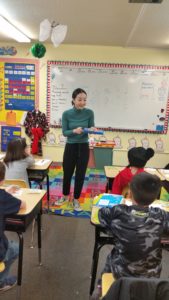
Our objectives:
• locate Japan on a map
• identify Japan as a country made up of four main islands
• identify the kimono as traditional Japanese clothing
• understand the importance of nature in Japanese traditional crafts
• understand the significance of bonsai, origami, and flower arrangements
•identify the bullet train of Japan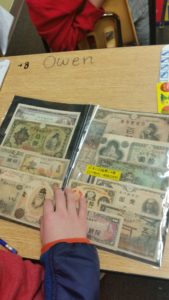
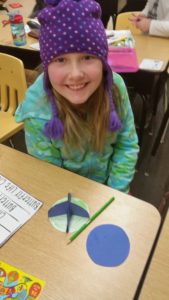
Starting our diorama
Science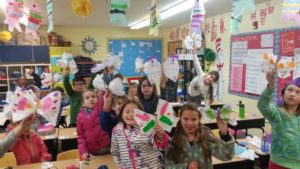
This week in our science domain Cycles in Nature we finished our work on the butterfly life cycle and began learning about the water cycle. The students worked on their butterfly life cycle diorama, made tissue butterflies and butterfly book marks.
Our objectives were to:
• explain that is cycle is a sequence of events that repeats itself again and again
• illustrate the life cycle of a butterfly and use proper vocabulary
• define the water cycle
• explain that there is a limited amount of water on Earth
• describe evaportation and condensation
English Spelling and Writing
Our idiom of the week was ” he’s pulling my leg.” The class wrote about the idiom and self edited their work in their journals. Our spelling assignment was to write each word 3 times and use them in a sentence. We had our sorts spelling test on Friday. Our new Word Wall words were: it’s, joke, just,
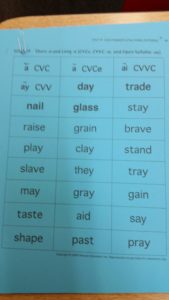
Next week’s sort for Blue group
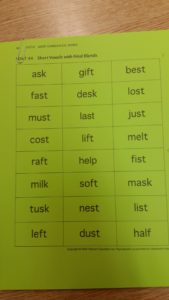
Next week’s sort for Green group
La lectura
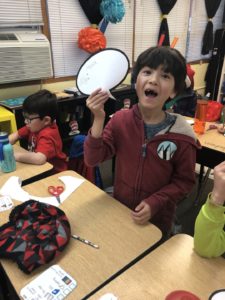 This week we read Corduroy.
This week we read Corduroy.
Our weekly objectives were to:
- Review words that begin with the letter h
- Read our story the 1st time focusing on the comprehension strategy making predictions
- Read our story a 2nd time focusing on the comprehension skill Making Inferences
- Understand when to use quotes in our writing and practice using them
Our PUF words for next week are: frío, flor, fruta
Las matemáticas
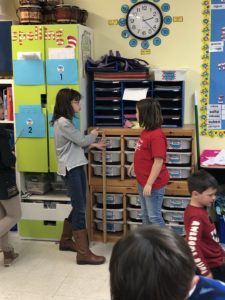 This week we completed our multiplication and division chapter and began working with measuring in meters. Our weekly objectives were to:
This week we completed our multiplication and division chapter and began working with measuring in meters. Our weekly objectives were to:
- Complete word problems using multiplication and division
- Demonstrate knowledge on the chapter test
- Compare items to a meter
Specialists:
Character Education
This month our theme is GENEROSITY. This past week we discussed different ways we can be generous out in the real world, such as buying a coffee for the person behind you in line, inviting a neighbor over for dinner, giving out snack bags to the homeless, or participating in a giving tree like we are doing at SWS. Our quote of the month is by Thomas Jefferson: “I believe that every human mind feels pleasure in doing good to another.” To celebrate the holiday season we are reading the famous poem “Twas the Night Before Christmas” and we are reading various books that focus on giving and generosity such as Silver Packages by Cynthia Rylant and Great Joy by Kate DiCamillo.
by Jill & Sarah | Nov 30, 2018 | In The Loop
 History & Geography
History & Geography
This week we have begun our next unit on Modern Day Japan. We learned about how rice and seafood are staple foods of Japan. We learned about the geography and important landmarks of Japan and that Tokyo is Japan’s capital, as well as a city of over 12 million people. The class worked on making a map of Japan and labeling important features. We also wrote “What Am I ?” haikus.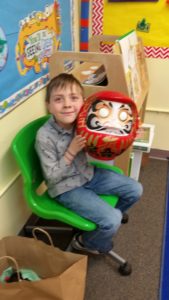
Our objectives:
• locate Japan on a map
• identify Japan as a country made up of four main islands
• recognize the Japanese flag and understand its symbolism
• understand the main geographical features and staple foods of Japan
• recognize that Japan is a modern industrial nation
• identify Tokyo at the capital and largest city
Science
This week in our science domain Cycles in Nature we continued to learn about butterflies. The students worked on making a life cycle flip book and practicing reading it. We learned a butterfly rap, and worked on our butterfly life cycle diorama.
Our objectives were to:
• explain that is cycle is a sequence of events that repeats itself again and again
• explain effects of seasonal changes on plants and animals
• define the term life cycle
• identify the stages of the light cycle of a butterfly (egg to egg)
• explain metamorphosis.
English Spelling and Writing
This week the class worked on their new spelling lists. They came up with several ways to sort their lists. On Friday we took our practice spelling test. In our journals we wrote about the idiom of the week “It goes in one ear and out the other.” Apparently reminders to do chores seems to be a popular subject to apply this idiom to. Our word wall words this week were: here, house, how, hurt
La lectura
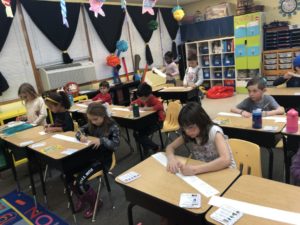 This week we read La casa de la mariposa.
This week we read La casa de la mariposa.
Our weekly objectives were to:
- learn the spelling of the /s/ sound through our PUF words
- understand correct use of commas in a list
- use the comprehension strategies summarizing and visualizing during our first read
- use the comprehension skills sequencing and point of view during our second read
Our PUF words for next week are lunes, miércoles, and martes.
Las matemáticas
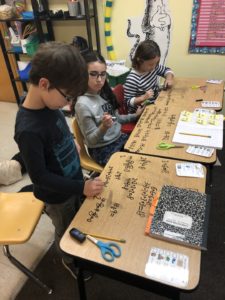 This week we continued learning about multiplication and division. Our weekly objectives were to:
This week we continued learning about multiplication and division. Our weekly objectives were to:
- solve division and multiplication word problems
- divide to share equally
- divide by repeated subtraction of equal groups
- multiply by repeated addition of equal groups
Specialists:
Art with Ms. Kelly
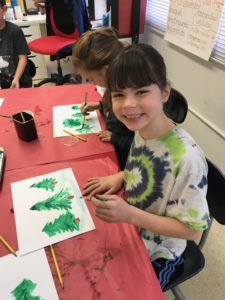 Figure Studies
Figure Studies
Figure Studies
Each year I like to do a Figure Study project with all the students. This is a good way for them to learn about and review the basic proportions when drawing a person. We start with cutting out basic geometrical shapes for the head, body, arms and legs, and the students make a simple standing person using a collage technique. Then they learn how to make a moving figure, such as a person running or jumping.
The 1st and 2nd graders did a great job with this! We looked at Henri Matisse’s cut-out figure called “Icarus” and the students also made crayon rubbings on top of their figure collages, which added another fun dimension to their figure studies.
Holiday Mural
After Thanksgiving, the students learned how to draw and paint Evergreen trees. We started with using the sides of oil pastels to create branches and a tree trunk. Then we switched to tempera paint, and the students learned how to use their paint brushes to create the texture of evergreen branches. Some of the small evergreen trees are on the Holiday Mural at school. I’ll be sending home the rest of these beautiful drawings and paintings loom so you can enjoy them over the holidays.
by Jill & Sarah | Nov 16, 2018 | In The Loop
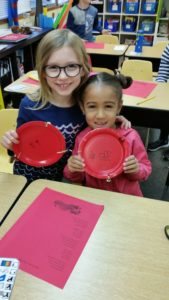
Making instruments for our Chinese New Year Parade.
History & Geography
This week we finished our unit on Ancient China. We learned all about the Chinese New Year. Students did some work with the Chinese zodiac calendar and worked on a Chinese counting book. On Friday, after we took our unit assessment, we celebrated with “New Year” activities and food. We even had our own Chinese New Year parade and sang our newly learned Chinese New Year song.
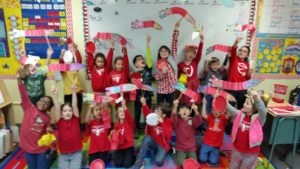
Let the parade begin!
Science
This week in our science domain Cycles in Nature we continued to learn about butterflies. The classed learned the cycle of a butterflies life and important vocabulary associated with each stage. The students worked on reading a butterfly book, making a life cycle flip book, and began making a butterfly life cycle diorama.
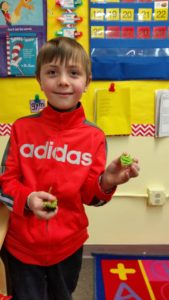
. . . . that relate to our studies
Our objectives were to:
• explain that is cycle is a sequence of events that repeats itself again and again
• explain effects of seasonal changes on plants and animals
• define the term life cycle
• identify the stages of the light cycle of a butterfly (egg to egg)
• explain metamorphosis.
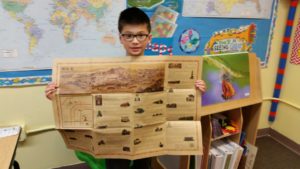
Sharing treasures from home . . . .
English Spelling and Writing
In our journals we used the idiom of the week, “Don’t let the cat out of the bag “. We had our sort spelling tests on Friday. Several students also took a Word Wall spelling test this week. Our new Word Wall words were: girl, gym, have
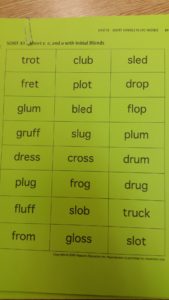
Green group’s next sort
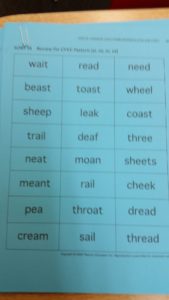
Blue group’s next sort
La lectura
This week we wrote thank you letters. Our weekly objectives were to:
- Review when to use capitals versus lower case letters
- Review when to use a colon and a comma in writing a letter
- Write a friendly letter letting someone know that you are thankful for them
Las matemáticas
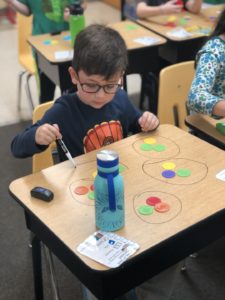
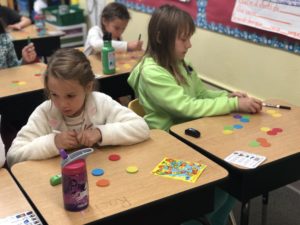 This week we began working with Multiplication. Our weekly objectives were to:
This week we began working with Multiplication. Our weekly objectives were to:
- Understand that multiplication is repeated addition
- Understand how to use equal groups to show multiplication
Specialists:
Character Education We have focused on the theme of gratitude, thankfulness and being content this month of November. We made a Thankfulness Book where each kid illustrated little pictures of things they are thankful for. We read a great book called “Those Shoes” about a boy really wanting a new pair of trendy shoes, but his family not having enough money to buy them. Our quote is “The best things in life are not things” and we talk about what this means. We are also reading the funny poem “The Turkey Shot Out of the Oven” by Jack Prelutsky. In December, we will set up our Giving Tree for Share so please look for it in the hallway and consider purchasing a gift for someone in need in our community!
by Jill & Sarah | Nov 9, 2018 | In The Loop
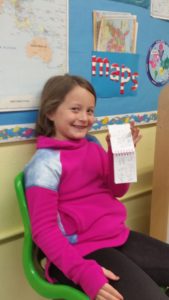
Sharing learned Chinese characters
History & Geography
This week in our unit on Ancient China we learned about the ancient process of making silk and the Silk Road. The class had fun acting out what traders might have encountered on the Silk Road. We also began to learn about the Chinese New Year.
Our objectives:
• recall the history of how silk was discovered
• understand how silk is made
• understand the cultural, economic, and geographic importance of silk
• identify the road from Europe to China as the Silk Road and know its significance
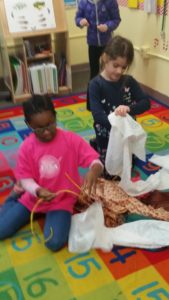
Making silk in China
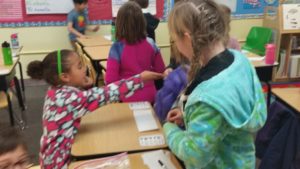
Trading at a Silk Road town
Science
This week in our science domain, Cycles in Nature, we finished editing and published our frog paragraphs. We began the next section of the science domain Cycles in Nature. We are now learning about butterflies.
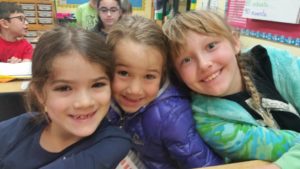
Picture day readiness
Our objectives were to:
• explain that is cycle is a sequence of events that repeats itself again and again
•identify introduction and conclusion sentences while listening to a paragraph being read.
•explain in writing facts about each stage of a frogs life cycle
• understand that the life cycle of a butterfly goes through a metamorphosis.
English Spelling and Writing
In our journals we used the idiom of the week, “He is a couch potato “. we got new spelling sorts this week and went over them in class. Your child should have brought one home on Monday. These sorts were also in last week’s newsletter. On Friday we took our practice spelling test, if students got a 100% on their practice test they will be tested on Word Wall Words next week for a chance to visit the treasure box . Our word wall words this week were: friends, float, found, green,
La lectura
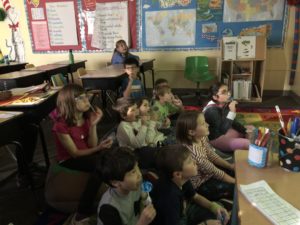
We earned a movie party this week! The kiddos enjoyed watching The Cat in the Hat Knows a lot About That in Spanish!
This week we read La grulla de papel.
Our weekly objectives were to:
- Understand and practice the letter y making the /i/ sound
- Understand that in Spanish we use lower case letters for days of the week and months
- Use the comprehension strategies making predictions and asking questions during our first read
- Use the comprehension skill sequence cause and effect during our second read
We will be reviewing all our high frequency words next week!
Las matemáticas
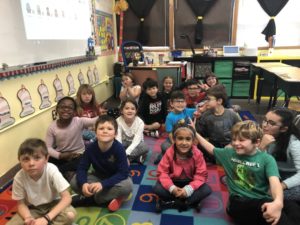 This week we finished working with Bar Models. Our weekly objectives were to:
This week we finished working with Bar Models. Our weekly objectives were to:
- Model addition and subtraction as comparing sets
- Apply the inverse operations of addition and subtraction
- Show what you know on the chapter test
by Jill & Sarah | Nov 2, 2018 | In The Loop
History & Geography
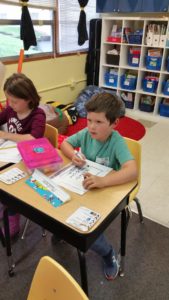
Practicing Chinese characters
We continued our unit on China this week. We learned more about Chinese writing and calligraphy as well as Chinese inventions. We did lots of activities centering on what we learned this week. We practiced Chinese characters, made carp kites, did some “woodblock” printing, 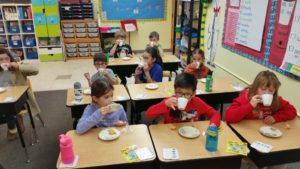 had a Chinese “tea” party. We also read several Chinese trade books.
had a Chinese “tea” party. We also read several Chinese trade books.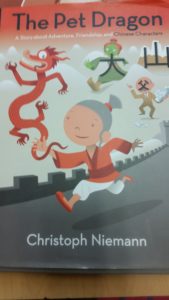
Our objectives:
• understand how the Chinese language is written and read
• recognize the historical and artistic value of writing to the Chinese
•recognize some of China’s important inventions
•understand that a tea party is considered a formal ceremony
Science
This week in our science domain Cycles in Nature, we continued to work on our frog paragraphs. We watched a short video on the stages of a frogs life cycle.
Our objectives were to:
• explain that is cycle is a sequence of events that repeats itself again and again
• identify the stages of the life cycle of a frog
•identify parts of a paragraph
•explain in writing facts about each stage of a frogs life cycle
• understand that with feedback, writers can revise their work
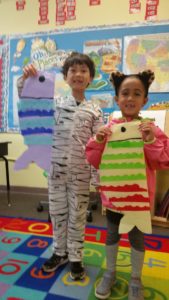 English Spelling/Writing
English Spelling/Writing
In our journals we used the idiom of the week, “He is catching some Z’s “. For spelling we did some Halloween related activities with our sorts. On Friday we took our spelling test, if students got a 100% on their practice test last week they were tested on Word Wall Words for a chance to visit the treasure box . Our word wall words this week were: every,
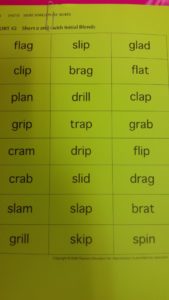
Next week’s Green Group sort list
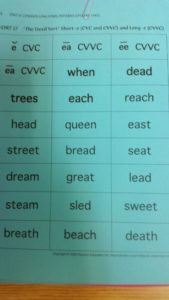
Next week’s Blue Group sort list
La lectura
This week we read Los duendes y el zapatero. Our weekly objectives were to:
- Understand and practice the vowel blends ia, ie, ua, and ue
- Understand the use of the colon in greeting and the comma in closings
- Use the comprehension strategies making predictions and asking questions during our first read
- Use the comprehension skill sequence and making inferences as we read the story a second time
Our high frequency words for next week are estoy, hay, voy, hoy, and soy.
Las matemáticas
This week we continued working with Bar Models. Our weekly objectives were to:
- Model addition as joining sets
- Model subtraction as taking away
- Apply the inverse operations of addition and subtraction
- Model addition and subtraction as comparing sets
by Jill & Sarah | Oct 26, 2018 | In The Loop
History & Geography
We continued our unit on China this week. We watched a video about the Great Wall of China and read about its history. We learned about Chinese language and writing and practiced writing some Chinese characters ourselves. On Tuesday we got to
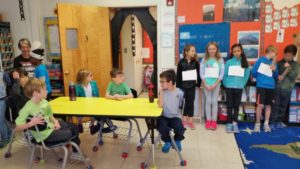
Learning about future history lessons from our peers.
see the 3/4 grade class put on an original play about Charlemagne.
Our objectives
• understand the importance of ancestors in Chinese beliefs.
• understand the ways that ancestor worship has been practiced
• recognize the Great Wall
• understand the feat of building the Great Wall
• understand how the Chinese language is written and read
• recognize the historical and artistic value of writing to the Chinese
Science
This week in our science domain Cycles in Nature, we finished learning about the life cycle of a frog. We spent the rest of week writing a paragraph about the life cycle of a frog. Students took notes, worked on a rough draft and we’ll finish editing these next week. We also learned the a fun new song about frogs.
Our objectives were to:
• explain that a cycle is a sequence of events that repeats itself again and again
• identify the 4 stages of the life cycle of a frog and use appropriate vocabulary when writing about these stages
• explain metamorphosis and amphibian
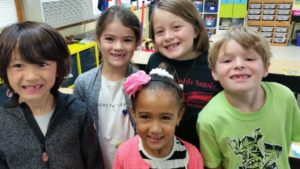
We all lost teeth this week!
English Spelling and Writing
In our journals we used the idiom of the week, “She is down in the dumps “. For spelling we worked on sorting our ways in a variety of way and took our practice test on Friday. Our word wall words this week were: children, clock, don’t, didn’t
La lectura
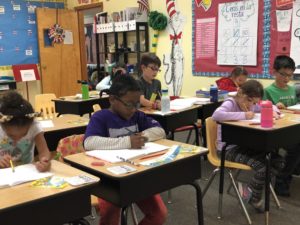 This week we reread Un hongo en la lluvia. Our weekly objectives were to:
This week we reread Un hongo en la lluvia. Our weekly objectives were to:
- Understand and practice the blends pr, pl, and dr
- Review using capital letters at the beginning of our sentences
- Use the comprehension strategies making predictions and summarizing
- Use the comprehension skill drawing conclusions
Our new high frequency words for next week are nueve, agua, and siete. Our review high frequency words for next week are bueno and gracias.
Las matemáticas
This week we finished working with subtraction up to 1,000 and began working with Bar Models. Our weekly objectives were to:
- Correct any missed problems on the math test
- Use bar models to solve addition and subtraction problems
- Apply the inverse operations of addition and subtraction
Specialists:
Music with Ms. Erin
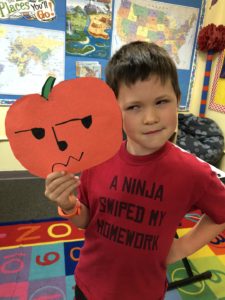 In October we learned about major and minor sounds, and how to sing the first five steps of the minor scale in Solfege. We introduced singing harmony. We learned about the xylophone and got to play student written songs on the glockenspiel. We also learned about Vivaldi, and listened to Autumn from his Four Seasons. We created Jack-o’-lanterns with faces made from musical notation symbols.
In October we learned about major and minor sounds, and how to sing the first five steps of the minor scale in Solfege. We introduced singing harmony. We learned about the xylophone and got to play student written songs on the glockenspiel. We also learned about Vivaldi, and listened to Autumn from his Four Seasons. We created Jack-o’-lanterns with faces made from musical notation symbols.
In November we will be focusing on various instruments, and the styles of music they are popularly used for – including piano (classical, jazz, rock), violin (classical, celtic fiddle, contemporary), and guitar (classical, blues, rock).
We will get to hear some famous pieces by composers Bach, Mozart, and Beethoven. We will also listen to classical violinist Itzhak Perlman, and contemporary violinist Lindsey Stirling.
Art with Ms. Kelly
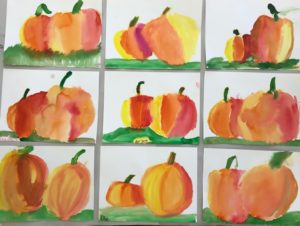 The first and second graders have painted some beautiful pumpkins this month. They learned how to overlap shapes to make their pumpkins look more realistic, and they used tempera paint to mix their own orange and green colors. The following week they used watercolors to make some more beautiful pumpkin paintings – these glowing pumpkins are on the bulletin board at the end of the hall.
The first and second graders have painted some beautiful pumpkins this month. They learned how to overlap shapes to make their pumpkins look more realistic, and they used tempera paint to mix their own orange and green colors. The following week they used watercolors to make some more beautiful pumpkin paintings – these glowing pumpkins are on the bulletin board at the end of the hall.
We also started a Chinese dragon picture, using a variety of textures. The students are learning how to combine stamping, collage (cut out shapes), and drawing to create a famous Chinese symbol. We also looks at Eric Carle’s book Dragons Dragons for inspiration. Hopefully we can finish these next week on Halloween!
Many thanks to Barbara Wagner for helping out in this class, as well as the 5th/6th grade class! She also provided several pumpkins and dried artichokes for all the students to observe for their various art projects.
by Jill & Sarah | Oct 19, 2018 | In The Loop
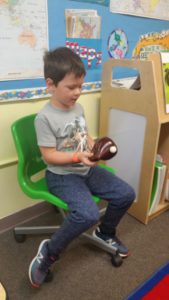
Sharing items from a trip to China
History & Geography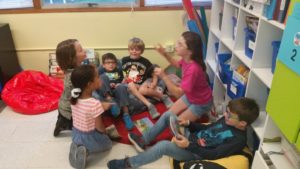
This week we continued our unit on China. We read a lesson on Confucius and the principals behind his philosophy. The class had fun breaking into group and acting out situations that showed people being virtuous. We also learned about significance of family and ancestors to the Chinese.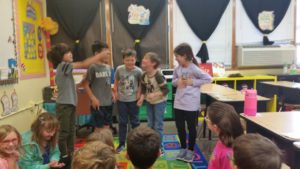
Our objectives
• understand the basic principles of Confucius
• recognize the influence of Confucianism on Chinese government and culture
• understand the importance of ancestors in Chinese beliefs
• understand the ways that ancestor worship has been practice
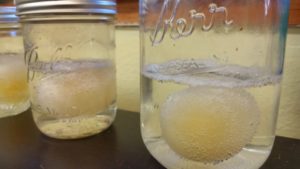 Science
Science
This week in our science domain Cycles in Nature, we finished learning about the life cycle of a chicken and began learning about the life cycle of frogs. We had fun with an egg experiment showing the chemical reaction of vinegar on an egg shell.
Our objectives were to:
• explain that is cycle is a sequence of events that repeats itself again and again
• identify the stages of the life cycle of a frog
• explain metamorphosis
• identify the different parts of a chicken egg
• explain how vinegar (an acid) reacts with calcium carbonate (egg shell) to change it into carbon dioxide, water, and aqueous calcium.
• observe the membrane underneath the egg shell.
English Spelling/Writing
In our journals we used the idiom of the week, “They’re going bananas “. For spelling we did two activities, and had both our practice and final tests. Our word wall words this week were: could, can’t,
La lectura
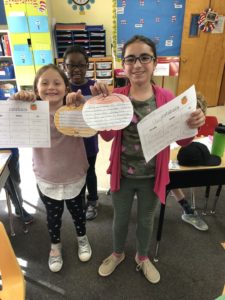
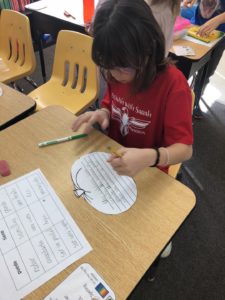 This week we reread Tomás y la señora de la biblioteca.
This week we reread Tomás y la señora de la biblioteca.
Our weekly objectives were to:
- review all the high frequency words we have learned this unit
- use the comprehension skill point of view as we read the story the second time
- Review possessive pronouns by creating possessive pronoun spiders
- Review common and proper nouns
Our high frequency words for next week are siempre, primero, and pronto
Las matemáticas
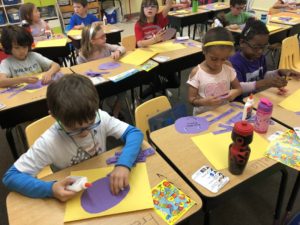 This week we continued working with subtraction up to 1,000. Our weekly objectives were to:
This week we continued working with subtraction up to 1,000. Our weekly objectives were to:
- Use base ten blocks to subtract with regrouping
- Apply the inverse operations of addition and subtraction
- Solve real-world subtraction problems
by Jill & Sarah | Oct 12, 2018 | In The Loop
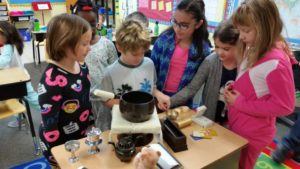 History & Geography
History & Geography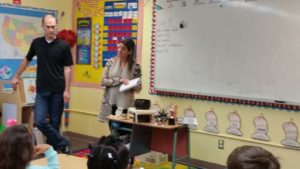
This week we finished our Ancient India unit and took the assessment. We had a presentation on modern day Buddhism by Carla and we got to try an assortment of Indian food. Our field trip to the Lan Su Chinese Garden and the Golden Horse restaurant was great! We were introduced to a variety of Chinese cultures and traditions. This was a wonderful way to kick off our next section on Ancient China.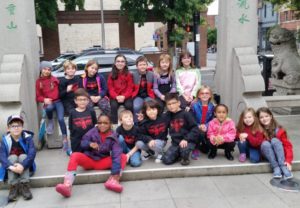
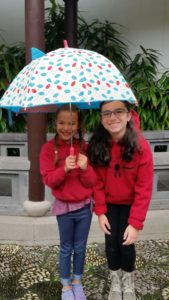 Our objectives
Our objectives
• find China on a map and identify some important land forms
• understand the role of China’s rivers in the formation of this ancient civilization
• describe how China’s rivers have been both helpful and destructive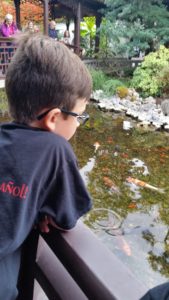
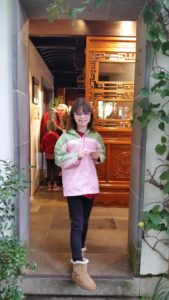
Science
This week in our science domain Cycles in Nature, we continued to learn about the life cycle of a chicken. We learned about the different parts of an egg and how it changes once it’s fertilized. The class watched a fast motion video that showed the chicken fetus developing inside the egg. We also did and egg experiment examining density.
Our objectives were to:
• explain that a cycle is a sequence of events that repeats itself again and again
• identify the stages of the life cycle of a chicken (egg to egg)
• identify and label the different parts of a chicken egg
• explain how freshwater and saltwater affect an egg’s ability to float.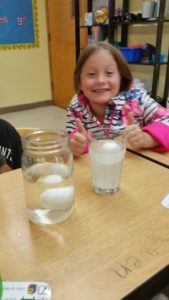
English Writing/Spelling
In our journals we used the idiom of the week, “He has butterflies in his stomache ” and we also wrote about the cycle of a chicken egg. For spelling I met with each group and went over the new sorts. Our word wall words this week were
La lectura
This week we read Tomás y la señora de la biblioteca.
Our weekly objectives were to:
- review all the high frequency words we have learned this unit
- use the comprehension strategies adjusting reading speed and summarizing as we read the story the first time
We had so much fun at the Pumpkin Run this week, it was great seeing kiddos cheering each other on.
Next week we will continue reviewing high frequency words from this unit!
Las matemáticas
This week we began working with subtraction up to 1,000. Our weekly objectives were to: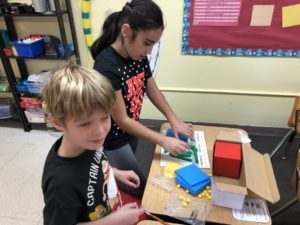
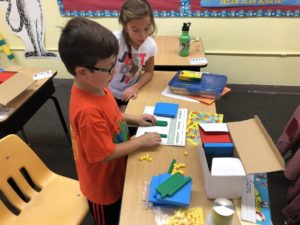
- use base 10 blocks to subtract numbers with and without regrouping
- subtract from three-digit numbers with and without regrouping
- apply the inverse operation of addition and subtraction
- solve real-world subtraction problems
Specialists:
Character Education
This month we are focusing on the theme of responsibility. We are talking about what this means in practical terms and of course it includes everything from helping our parents/families and doing our schoolwork to taking responsibility for our mistakes by telling the truth, apologizing, and accepting the consequences (no excuses, blame-shifting, etc.). We have a fun little song to the tune of Mickey Mouse that helps us remember what responsibility looks like. We read the Aesop’s fable The Ant and the Grasshopper about the responsible ant who stored up food for the winter and the lazy grasshopper who lazed around instead. And then we’ll be reading Horton Hatches the Egg next week! We are focusing on how our actions have consequences!
by Jill & Sarah | Oct 5, 2018 | In The Loop
History & Geography
This week we had our own Diwali celebration. We made clay pot lanterns and decorated our black top with Rangoon designs using chalk. We also learned about the stories of how Buddha came to be and about King Asoka.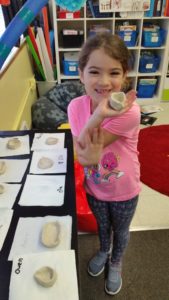
Our objectives
• understand how Prince Siddhartha became Buddha
• identify Buddhism
• listen to Buddhist Jataka Tale and understand it’s lesson
• identify King Asoka
• understand how Asoka spread Buddhism
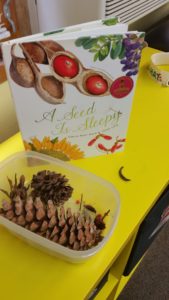 Science
Science
This week in our science domain Cycles in Nature, we continued to learn about trees. The class examined different kinds of seeds that come from trees and we made a diagram of the life cycle of an apple tree. On Friday we began learning about the life cycle of a chicken. The class had fun learning the song “Which Came First, The Chicken or the Egg?”
Our objectives were to:
• explain that a cycle is a sequence of events that repeats itself again and again
• explain the effects of seasonal changes on plants and animals
• define the term life cycle
• identify the stages of the life cycle of a tree.
•Identify different ways that trees spread their seeds
• explain the difference between deciduous and Evergreen trees.
• identify the stages of the life cycle of a chicken (egg to egg)
English Writing/Spelling
In our journals we used the idiom of the week, “Put your thinking cap on ” and we also wrote about the story of Buddha and the Tree of Life. For spelling we went over our practice test and reviewed the vowel patterns that we need to work on. Students who have a hundred percent on their practice test do not have to take the spelling test on Friday. Our word wall words this week were: because, before, best, beautiful
La lectura
This week we read La hora de cuentos: ¡Con la participación especial de Megan! Our objectives were:
- use the comprehension strategies making connections and making predictions when reading our story the first time
- use the comprehension skill Making Inferences when reading our story the second time
- learn and practice using possessive pronouns
- practice that gi and ge make the /h/ sound with our high-frequency words
Next week we will be reviewing all our high-frequency words that we have learned so far!
Las matemáticas
This week we finished our chapter on 3-Digit Addition. Our objectives were:
- add up to three-digit numbers with regrouping in the tens
- add up to three-digit numbers with regrouping in the ones and tens
- demonstrate our understanding of three digit addition on the chapter test
Specialists:
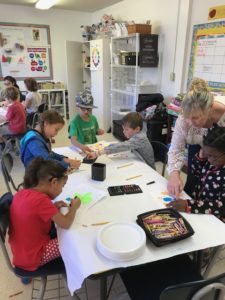 The students finished their beautiful Fall Landscape and Tree pictures, which had vivid colors and shapes similar to a stained glass window.
The students finished their beautiful Fall Landscape and Tree pictures, which had vivid colors and shapes similar to a stained glass window.
To go along with their study of India, the 1st and 2nd graders have been learning about Alpana artwork that is used in India during celebrations such as Diwali (Festival of Lights). The students learned how to fold paper to create guidelines on which to draw a symmetrical design. They are using neon oil pastels and watercolor to make some beautiful designs! (To be finished next week)
This month we’ll work on a Chinese Dragon picture. Other projects for October include drawing a painting a Pumpkin Still Life, and creating texture with Leaf Rubbings.
 History & Geography
History & Geography


 This week we completed our multiplication and division chapter and began working with measuring in meters. Our weekly objectives were to:
This week we completed our multiplication and division chapter and began working with measuring in meters. Our weekly objectives were to:








 Figure Studies
Figure Studies






















 In October we learned about major and minor sounds, and how to sing the first five steps of the minor scale in Solfege. We introduced singing harmony. We learned about the xylophone and got to play student written songs on the glockenspiel. We also learned about Vivaldi, and listened to Autumn from his Four Seasons. We created Jack-o’-lanterns with faces made from musical notation symbols.
In October we learned about major and minor sounds, and how to sing the first five steps of the minor scale in Solfege. We introduced singing harmony. We learned about the xylophone and got to play student written songs on the glockenspiel. We also learned about Vivaldi, and listened to Autumn from his Four Seasons. We created Jack-o’-lanterns with faces made from musical notation symbols. The first and second graders have painted some beautiful pumpkins this month. They learned how to overlap shapes to make their pumpkins look more realistic, and they used tempera paint to mix their own orange and green colors. The following week they used watercolors to make some more beautiful pumpkin paintings – these glowing pumpkins are on the bulletin board at the end of the hall.
The first and second graders have painted some beautiful pumpkins this month. They learned how to overlap shapes to make their pumpkins look more realistic, and they used tempera paint to mix their own orange and green colors. The following week they used watercolors to make some more beautiful pumpkin paintings – these glowing pumpkins are on the bulletin board at the end of the hall.


















 The students finished their beautiful Fall Landscape and Tree pictures, which had vivid colors and shapes similar to a stained glass window.
The students finished their beautiful Fall Landscape and Tree pictures, which had vivid colors and shapes similar to a stained glass window.